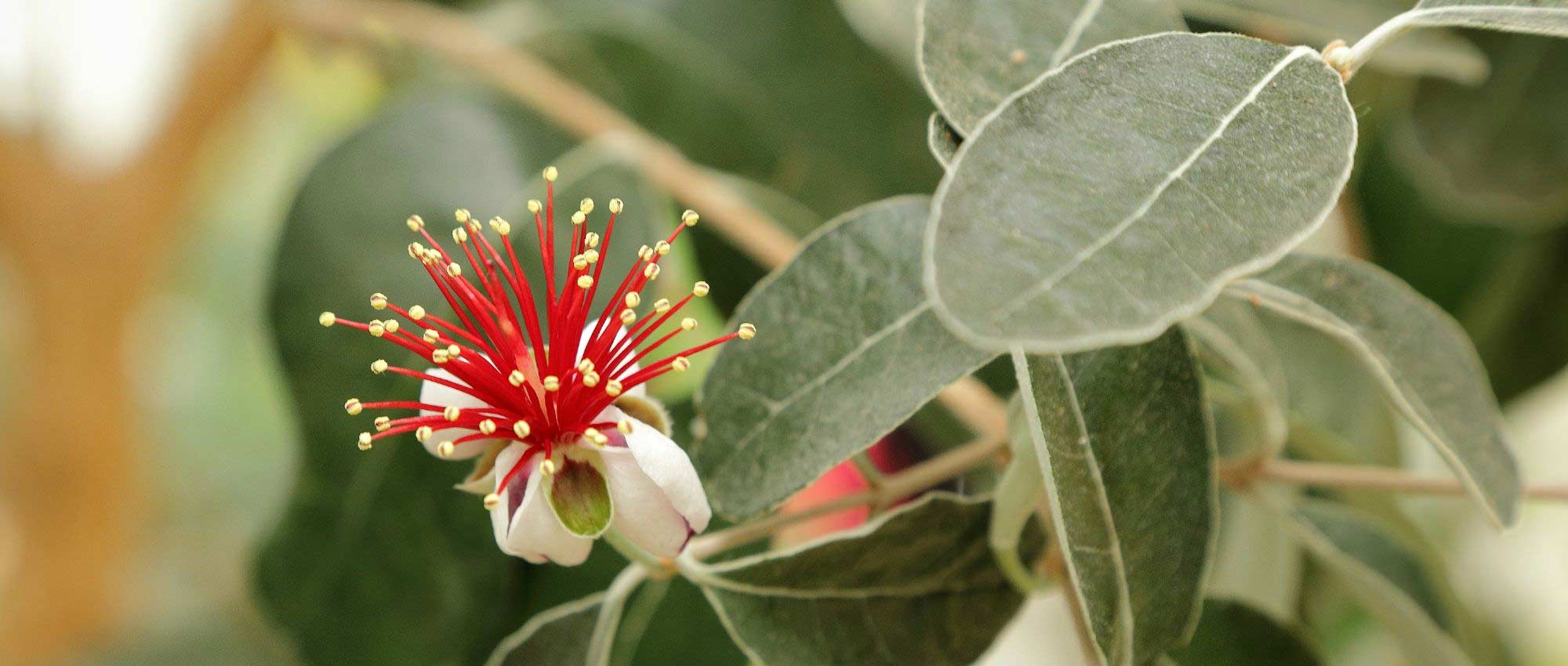
Feijoa sellowiana, pineapple guava: planting, growing and harvesting
Contents
Feijoa in a nutshell
- Feijoa produces an unusual white-and-red flowering in spring.
- It is a dense bush with a rounded habit, somewhat spreading
- It has attractive evergreen foliage, dark green above and silvery beneath.
- Its edible fruits, harvested in autumn, are much appreciated.
- Relatively hardy, it can withstand −10 °C
A word from our Expert
Feijoa or Pineapple guava, known botanically as Acca sellowiana, is a small exotic fruit tree, which bears evergreen, dark green foliage, silvery beneath, and an original flowering display of white flowers with numerous red stamens. Moreover, its petals are edible and can be used to garnish a salad, for example! But what people particularly love about Feijoa are its fruits, whose flavour lies between pineapple, guava and strawberry. It is a bush with a dense, spreading habit, well ramified, and it also has very attractive bark.
In the garden, Feijoa will thrive in full sun, sheltered from cold winds. It is fairly hardy, tolerating −10 °C, but still needs warmth to set fruit. Thus it fruits much better in regions with a mild climate. Generally, several Feijoa should be planted to allow cross-pollination. However, in cultivation self-fertile varieties are available, which bear fruit even when the bush is planted alone. Feijoa is fairly resilient and not very susceptible to diseases or pests. It also tolerates pruning very well. This bush requires little maintenance, although regular watering during fruiting is preferable.
Description and botany
Botanical data
- Latin name Acca sellowiana
- Family Myrtaceae
- Common name Feijoa, pineapple guava, Brazilian guava
- Flowering spring (May–June)
- Height up to 6 m
- Exposure full sun
- Soil type ordinary, light, well-drained, fertile
- Hardiness -10 °C
Feijoa is a large evergreen bush that offers decorative foliage and unusual flowering, followed by edible fruit. Its scientific name is Acca sellowiana, but in French it is commonly called Goyavier du Brésil because it originates from South America and belongs to same family as true guava. In the wild it is found in southern Brazil, Uruguay, Paraguay, Colombia and northern Argentina.
Although three species exist — Acca sellowiana, Acca lanuginosa and Acca macrostema — the first is mainly cultivated; it was formerly named Feijoa sellowiana. About twenty horticultural varieties have been obtained by hybridization. Feijoa is grown for its fruit in Florida, California, New Zealand and Australia, but fruit are generally sold locally rather than exported, because they keep poorly after harvest and spoil quickly. Feijoa pulp is also used in some natural cosmetics for its exfoliating properties.
Contrary to what one might expect of an exotic bush, Feijoa has good hardiness, able to withstand down to −10 °C, which makes it easy to grow in our climates. Exposed to lower temperatures (down to −15 °C), Feijoa may lose leaves and stop fruiting, but the bush itself should not be damaged.
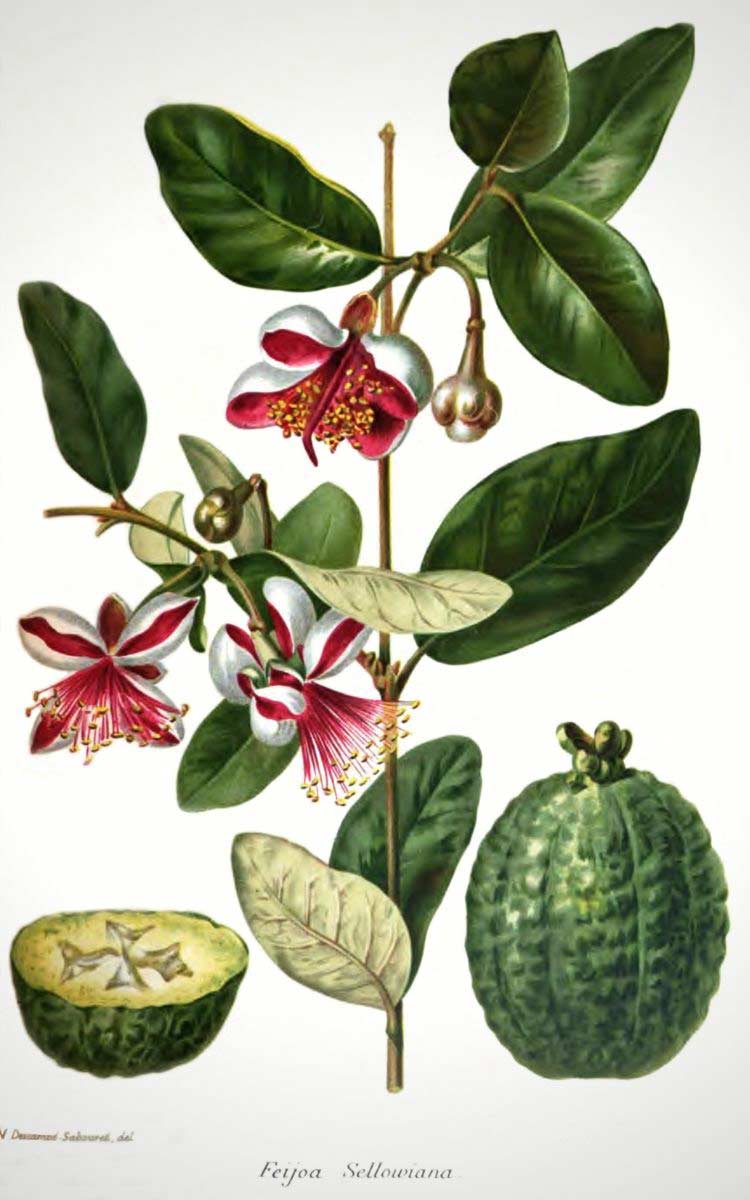
Acca sellowiana: botanical illustration
Feijoa belongs to family Myrtaceae, which comprises nearly 6,000 species. These are trees and bushes, often native to Australia or South America, some of which produce essential oils used for fragrance or medicinal properties. Examples in this family include myrtle, eucalyptus, clove tree, Callistemon and Melaleuca. True guava (Psidium guajava) also belongs to this large family.
Feijoa was named in honour of Portuguese naturalist João da Silva Feijó (1760–1824). The species name sellowiana refers to Friedrich Sellow, a German botanist who collected specimens in South America. In French it is often nicknamed Goyavier du Brésil. It is also sometimes called pineapple guava or Montevideo guava.
This is a bushy, well-ramified plant with a fairly wide, rounded habit. It grows rather slowly at first, during first four or five years while establishing. It reaches 6–7 m in height at most, and can live for more than 50 years. Feijoa has brown bark that flakes in small plates, revealing a beautiful red tinge on younger wood. Young shoots are covered in a silvery down.
Feijoa bears attractive dark green–grey foliage. Leaves are simple, undivided, of a fairly ordinary elliptical shape, with a well-marked central vein. They generally measure between 6 and 8 cm in length and are thick and leathery. Beneath, they are silvery and downy. Leaves are opposite, arranged in pairs on stems. Feijoa foliage is fairly dense, making it an effective privacy screen and useful for informal hedging. It is also evergreen, remaining decorative in winter.
Feijoa roots are fairly shallow, staying near soil surface.
Feijoa produces a handsome spring flowering in May–June. Flowers are solitary and measure about 3.5 cm in diameter. They usually have four petals, though some may have three, five or six. Petals are fleshy, white on the back and pinkish-red on the inside. Their edges are rolled upwards, partly hiding the pink inner surface. Flowers usually have four sepals. At centre of petals is a cluster of long, bright red stamens whose yellow tips (anthers) bear the pollen. These stamens are numerous, often between 80 and 100 per flower. Among them is a long red style (female reproductive organ that will receive pollen).
In its natural habitat, some birds eat the petals and pollinate the flower at same time. And even for humans, Feijoa petals are edible. They have a sweet, slightly sugary flavour with a faint cinnamon note. Petals can be added to salads or used to decorate dishes. If harvesting petals, pick them gently and take only petals so remainder of flower can develop into fruit.
Feijoa requires cross-pollination to produce fruit, which means a single bush generally cannot pollinate itself. To obtain fruit, plant at least two young plants in garden. However, a few self-fertile varieties exist, such as Acca sellowiana ‘Coolidge’.

Flowering of Acca sellowiana (photo Christer T Johansson), and its fruits (photo Didier Descouens)
In autumn, Feijoa produces oval green fruits with rough skin that resemble small avocados and measure about 6–7 cm in length. They have white or cream flesh and contain pips. They are usually harvested in November; ripe fruit then fall from bush. Flavour is sweet, recalling pineapple, banana and strawberry. Fruits can be eaten raw or used to make jam or compote. They also make tarts and cakes, sorbets, or can be added to fruit salad.
Main varieties of Feijoa

Acca sellowiana
- Flowering time June, July
- Height at maturity 4 m
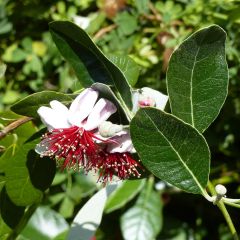
Feijoa sellowiana Coolidge
- Flowering time July, August
- Height at maturity 4 m
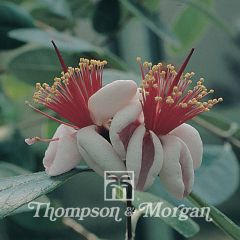
Feijoa sellowiana
- Flowering time July to September
- Height at maturity 2,50 m
Discover other Feijoa trees - Acca
View all →Available in 1 sizes

Available in 2 sizes
Available in 3 sizes
Available in 1 sizes
Available in 1 sizes
Available in 1 sizes

Available in 1 sizes
Planting Feijoa
Where to plant?
Plant your Feijoa in full sun. It needs warmth and plenty of light to produce generous flowering and fruiting. Position it sheltered from cold winds. Ideally install it near a south-facing wall. Mild temperatures, or a greenhouse, are required for the fruits to reach ripeness. You can plant Feijoa in a large container, which allows you to bring it indoors in winter.
It prefers rich, fertile, loose, light soil. It also likes well-draining substrates that do not retain too much moisture in winter. It is fairly tolerant of drought. If your ground is heavy, compact or clayey, try to lighten it and improve drainage, for example by adding organic matter. Feijoa prefers slightly acidic or neutral soils. In general, Feijoa is not very demanding about soil type and will succeed in any good garden soil.
It is a bush suitable for coastal gardens. It enjoys mild temperatures and can tolerate sea spray and salt. Feijoa’s shallow root system has the advantage of holding soil and limiting erosion, which is useful on slightly sloping or unstable sites, or by the sea.
Feel free to include Feijoa in an informal hedge. Its dense, evergreen foliage will provide an effective screen.
When to plant?
We recommend planting it in spring (April–May), although planting is also possible in autumn if you live in a mild climate.
How to plant?
We recommend planting at least two young plants of Feijoa to obtain fruit, as they require cross-pollination (unless you grow self-fertile varieties).
- Start by digging a large planting hole, two or three times the size of the rootball.
- Add well-rotted compost to enrich the soil.
- Remove your Feijoa from its pot and gently tease the rootball to loosen some roots and stimulate them.
- Plant, taking care not to bury the collar.
- Backfill the soil around the Feijoa.
- Water generously.
You can also install a stake to support the Feijoa and help it grow upright, especially if your garden is exposed to wind.
Also consider forming a watering basin around the trunk to make watering and water infiltration at its base easier. Water regularly during the weeks following planting.
You can plant it in a large pot or container so you can easily bring it indoors in winter. Use a well-draining, fairly rich substrate, for example potting compost mixed with a little well-rotted compost and coarse sand. Place the pot in full sun, sheltered from wind if possible.
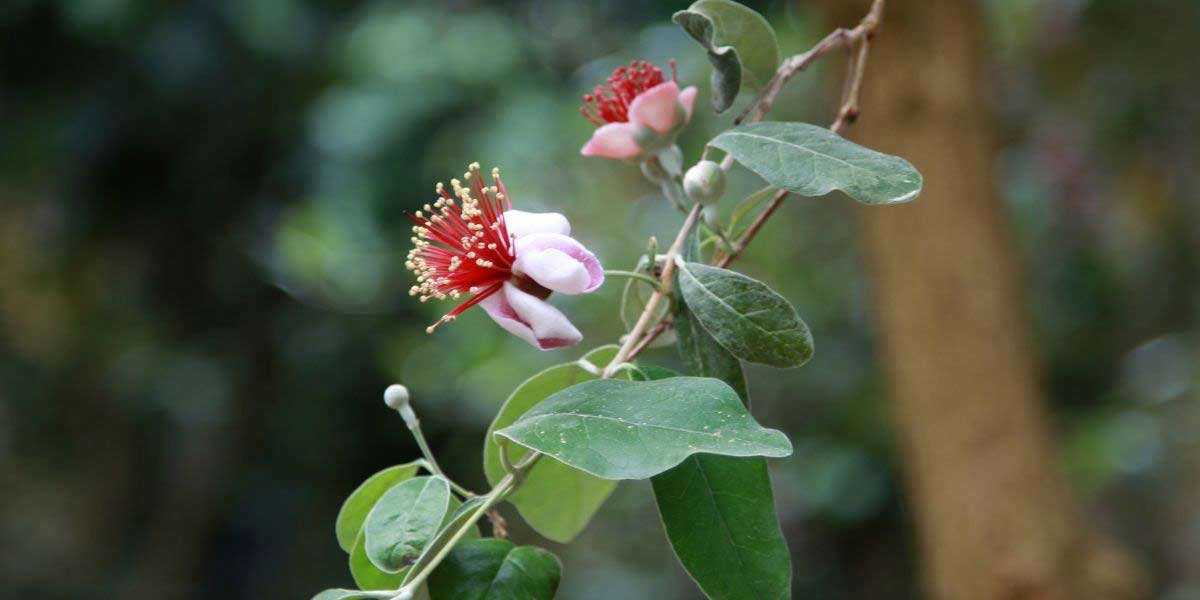
Care
Feijoa is fairly drought-tolerant, but prolonged lack of water will harm fruiting. If growing for its fruit, be more vigilant about watering. Similarly, during year of planting, do not hesitate to water regularly. Afterwards, Feijoa will appreciate occasional waterings during prolonged drought. Be careful if grown in a pot: waterings will need to be much more frequent than in the ground, as potting mix dries out quickly.
Feijoa prefers rich soils, which is why we recommend adding well-rotted compost each year. Place it at its base and incorporate superficially into soil by lightly forking or scratching the surface. You can also lay a layer of organic mulch to help soil stay cool longer and to protect the bush from cold. As Feijoa’s root system is shallow, remaining close to soil surface, spreading a layer of mulch will really help protect its roots from heat, drying out or cold in winter.
If you live in a cold area and your Feijoa is planted in the ground, we recommend wrapping it in winter fleece and laying a thick layer of mulch at its base. If in a pot or container: in October you can bring it under cover, into a conservatory or cold greenhouse, and put it back outdoors in spring, around May. Feijoa is relatively hardy but cold can damage flowering and fruit production. Feijoa produces less well when grown in cool regions, because low temperatures damage flower buds, preventing fruit development.
If growing Feijoa in pot or container, consider repotting on average every two years, or carrying out a top-dressing.
Feijoa is known to grow slowly, but it will grow faster in rich, moist soil than in poor, dry substrate. So do not hesitate to add compost, mulch and to water occasionally when necessary.
Feijoa is rarely affected by diseases and pests. However it can be affected by scale insects. You can get rid of them by using black soap diluted in water.
→ Learn more about Feijoa diseases and pests in our advice sheet!
Prune Feijoa preferably in late winter, around March; but it is also possible to do so in autumn, after harvest. In any case, it is a bush that tolerates pruning very well. You can leave it with a fairly natural, well-branched habit from the base, giving a bushy effect, or conversely prune it into a standard to form a very straight trunk without lower branches, which becomes denser higher up to form a rounded clump of foliage. Prioritise pruning the lowest branches to showcase the trunk and to lighten it. If lower part of bush is cleared, this will also make it easier to access fruits that have fallen to the ground for harvest. Also remove dead, damaged or broken branches, and those that cross. As Feijoa is a fairly dense and well-branched bush, we recommend removing some branches from centre of the crown to open it up and allow light to penetrate.
Harvest and uses of pineapple guavas
Feijoa fruits are usually harvested from mid-October and throughout November. Temperatures need to be mild enough for fruits to ripen. From outside it is difficult to see whether fruit is fully ripe. When it is, it falls from the tree. You can gently shake branches to collect fruits that come off the tree and are therefore ready to eat. Once harvested, fruit does not keep for very long.
In addition to its pleasant flavour reminiscent of pineapple, guava and strawberry, Feijoa fruit is particularly rich in vitamin C. To eat it, cut it in half and eat each half with a spoon, scooping out only the flesh, as you would with a kiwi. Skin is also edible, but not as pleasant-tasting as the rest of the fruit. Feijoa can be added to smoothies, or used to make jams, jellies, tarts or compotes. Finally, you can keep the pips found in the fruits to propagate Feijoa by sowing.
→ Learn more in our tutorial : How to harvest and store Feijoa fruits?
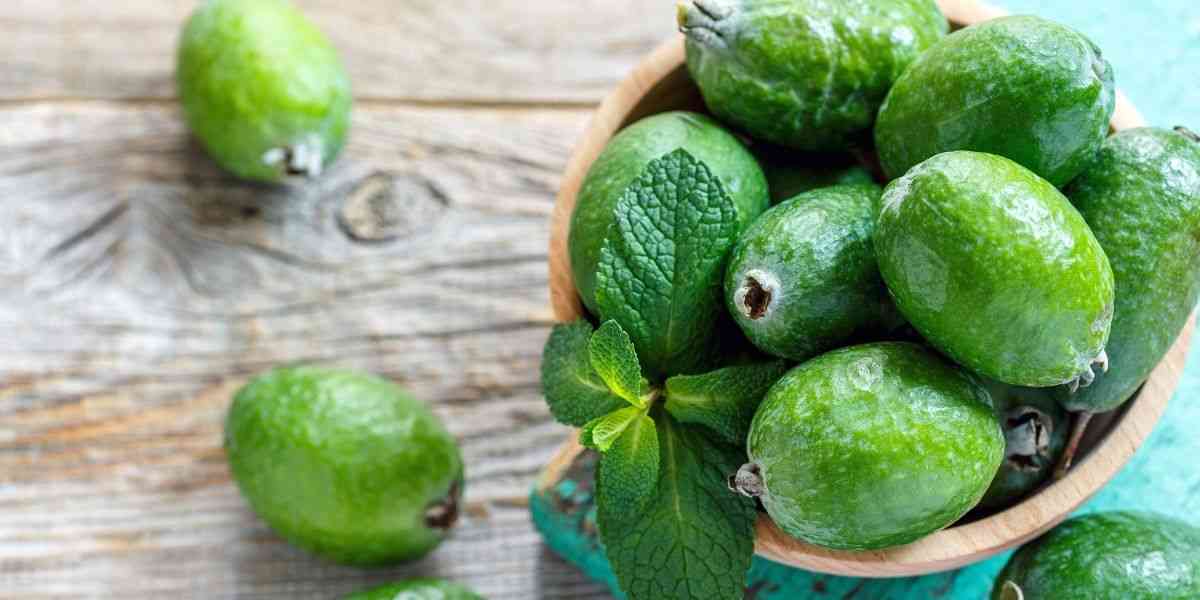
Propagation: sowing
To propagate Feijoa, sowing or propagation by cuttings are mainly used, although it is also possible to graft or to layer. Propagation by cuttings is carried out in summer by taking heel cuttings from semi-woody shoots. It is rather tricky to succeed, so we recommend sowing instead. However, when successful, propagation by cuttings produces fruit more quickly than sowing.
Sowing
Carry out sowing in spring. You can sow seeds you have collected yourself from fully ripe fruit. In this case, rinse seeds before sowing to avoid any pulp remaining around them.
- Fill a pot with a light, well-draining substrate, for example a mix of potting compost and sand.
- Sow seeds.
- Cover with a thin layer of substrate.
- Water with a fine mist.
- Place pot in a bright, sheltered spot at around 15 °C.
Seeds take between 3 and 5 weeks to germinate. As soon as seedlings are large enough to handle, pot them into individual pots. Growth of young plants is fairly slow, and you will have to wait at least four years before enjoying first fruits.
Companion planting
We recommend pairing Feijoa with other exotic and unusual fruit trees. You can thus create an exceptional orchard by planting it, for example, alongside fig trees, sea buckthorns, kiwifruit, nashis…Also enjoy Kaki (Diospyros kaki), a tree that, in addition to its delicious fruit, offers beautiful autumn colours! You can also plant young Goji plants (Lycium barbarum). Don’t forget Strawberry tree, a very attractive bush with decorative bark and rounded red fruits that resemble strawberries. Also consider citrus trees, such as mandarin, yuzu or lemon tree.
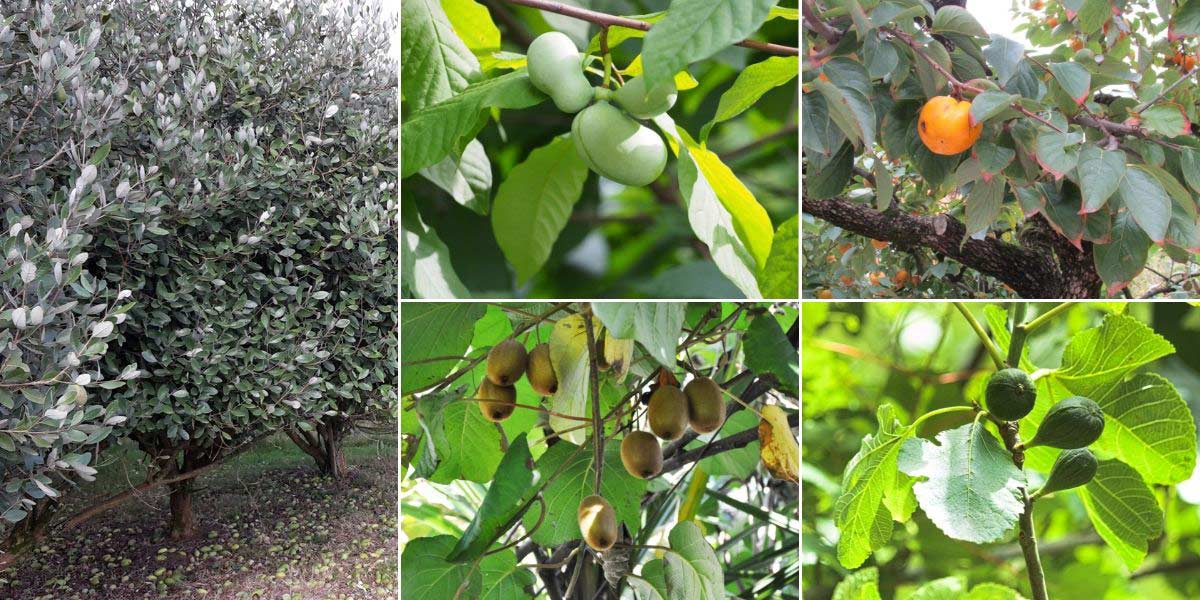
You can pair Feijoa with other unusual or exotic fruit trees. Feijoa (photo Arn), Asimina triloba (photo Agnfieszka Kwiecień), Kaki (photo Chris Light), Kiwi (photo Lazaregagnidze) and Fig tree
For a truly exotic, transportive ambience, you can plant Feijoa alongside banana plants, palms and Yuccas. These plants, with their impressive silhouettes, will help structure garden and add height. In front of them you can install lower-growing plants such as euphorbias, lantanas or wallflowers. For lightness, you can add a few grasses such as Carex comans ‘Bronze Form’ or Imperata cylindrica ‘Red Baron’.
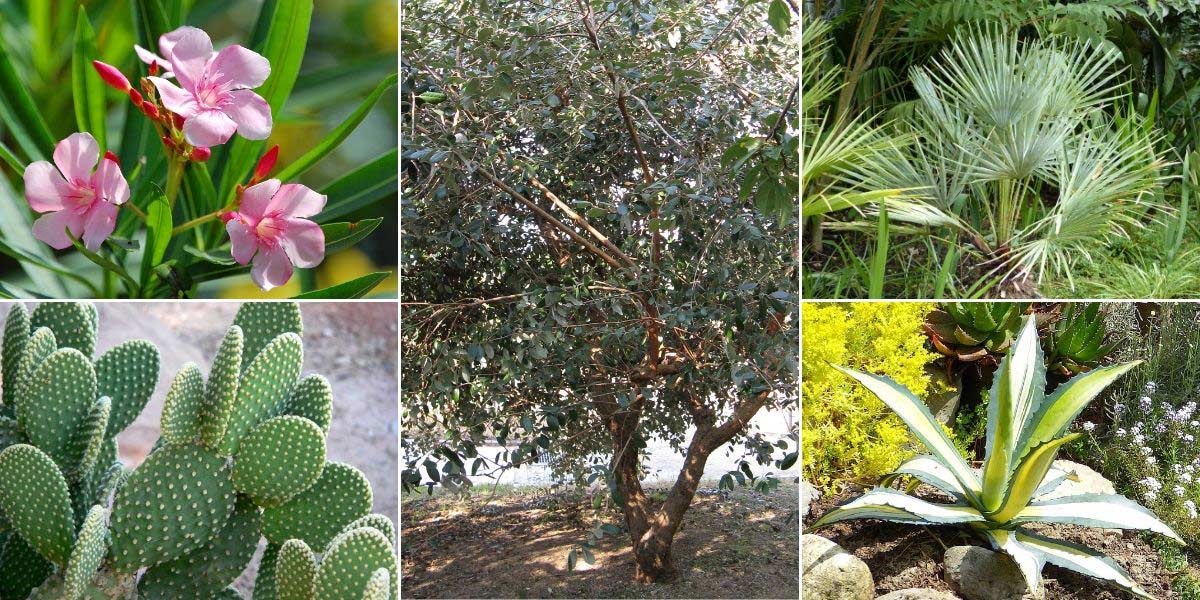
For a Mediterranean ambience, for example in a seaside garden: Oleander (photo Challiyan), Opuntia microdasys (photo Stan Shebs), Feijoa (photo KENPEI), Chamaerops humilis ‘Cerifera’ and Agave mediopicta ‘Lutea’
If you live by the sea, make the most of Feijoa to create a Mediterranean-style garden. This bush has the advantage of tolerating spray and salt well, and mild seaside temperatures will be particularly favourable to establishment and good fruit production. You can plant it alongside Agaves, Opuntia, Helichrysum, santolina… You can also use it in an informal hedge with Griselinia, oleander and Eleagnus. For more ideas of bushes, see our advice sheet “10 perfect bushes for a seaside garden”
Useful resources
- Discover our range of unusual and exotic fruit trees
- An article by Ingrid on our blog : “7 exotic and hardy fruit trees to grow in the garden”
- A site about rare fruit trees, with lots of information on Feijoa
- We help you choose your Brazilian guava or Feijoa in our buying guide!
Frequently asked questions
-
My feijoa is not producing (or is producing very few) fruit. Why?
Feijoa often has very poor fruiting caused by pollination problems. It needs cross-pollination to develop fruit. We therefore recommend planting several young plants so they can pollinate each other, or to grow self-fertile varieties such as Acca sellowiana ‘Coolidge’.
Depending on region where you live, your climate may not allow Feijoa fruit to develop. Although bush can withstand down to −10 °C, low temperatures can compromise flowering and fruiting.
Finally, your Feijoa may be too young. When obtained from sowing, wait at least four years before first fruits appear. Likewise, if it is an adult specimen but has suffered a major shock, such as transplanting, severe frost or prolonged drought, this will probably prevent fruiting. In that case, simply wait a little for it to be ready to produce fruit again.
- Subscribe!
- Contents
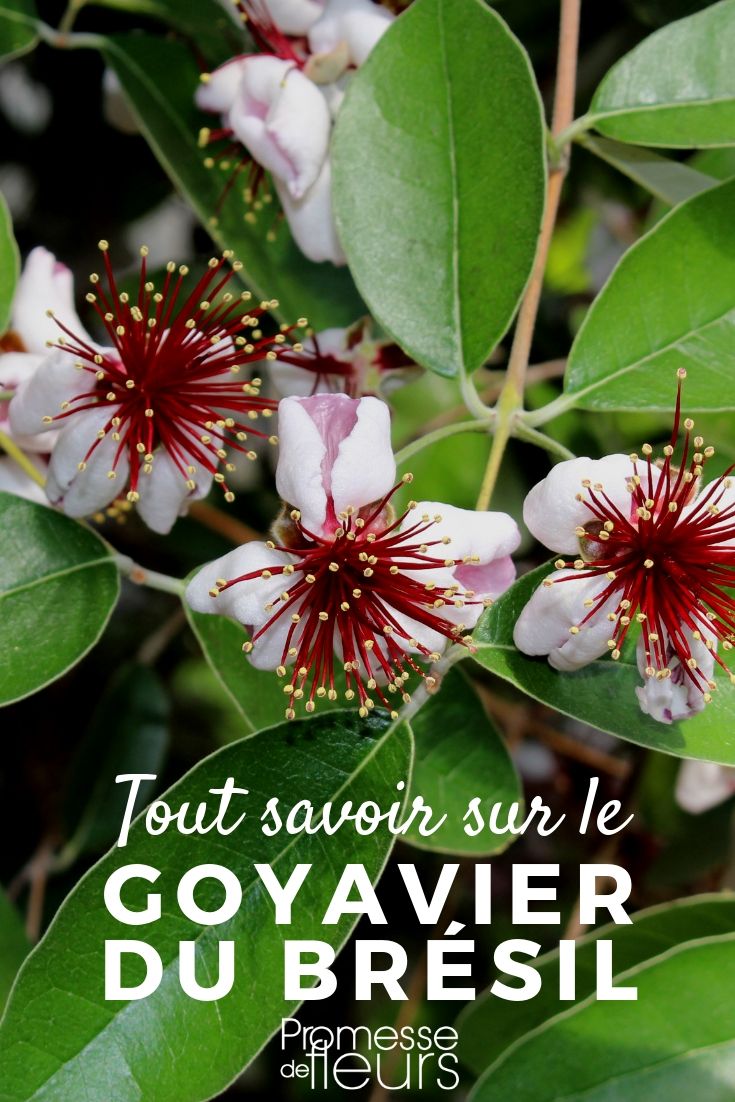































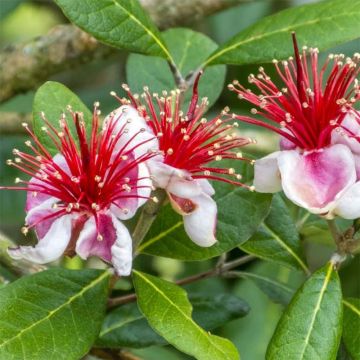
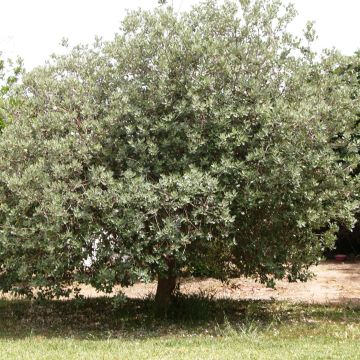
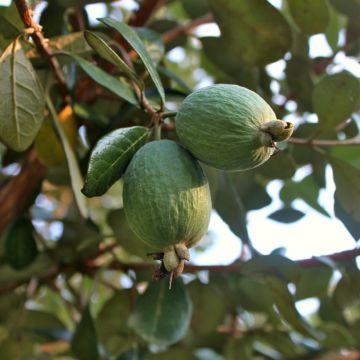
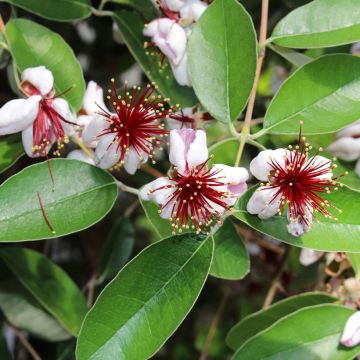
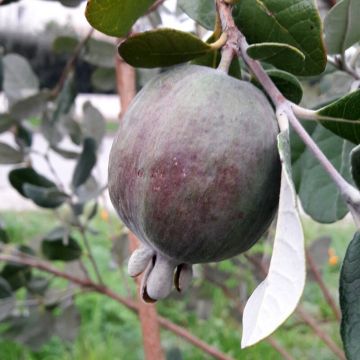
Comments